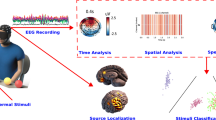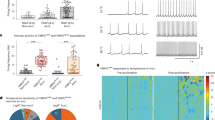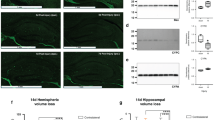Abstract
A REGION of the brain sensitive to temperature has been described as between the optic chiasma and the anterior commissure in the cat1. Direct heating of this region with diathermy was shown to induce panting. In the goat, panting was found2 to continue for 1–2 min. after the end of 5 min. of electrical stimulation in the corresponding region of the brain, and to be effective in lowering the temperature of the animal. Moderate heating of this region in the cat and the rabbit was also found3 to reduce gamma motor activity. The present experiments serve to identify an efferent pathway from this temperature-sensitive region.
This is a preview of subscription content, access via your institution
Access options
Subscribe to this journal
Receive 51 print issues and online access
$199.00 per year
only $3.90 per issue
Buy this article
- Purchase on SpringerLink
- Instant access to full article PDF
Prices may be subject to local taxes which are calculated during checkout
Similar content being viewed by others
References
Magoun, H. W., Harrison, F., Brobeck, J. R., and Ranson, S. W., J. Neurophysiol., 1, 100 (1938).
Andersson, B., Grant, R., and Larsson, S., Acta Physiol. Scand., 37, 261 (1956).
Euler, C. von, and Soderberg, U., EEG Clin. Neurophysiol., 9, 391
Author information
Authors and Affiliations
Rights and permissions
About this article
Cite this article
CRAGG, B. A Heat-Loss Mechanism involving the Habenular, Interpeduncular and Dorsal Tegmental Nuclei. Nature 184, 1724 (1959). https://doi.org/10.1038/1841724a0
Issue date:
DOI: https://doi.org/10.1038/1841724a0



